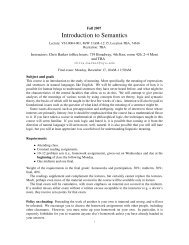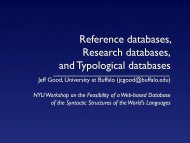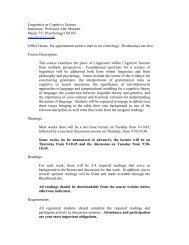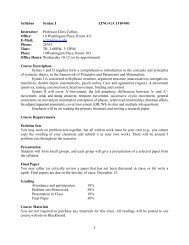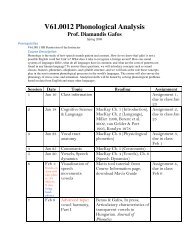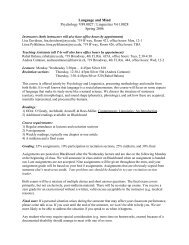<strong>NYU</strong> Work<strong>in</strong>g Papers <strong>in</strong> L<strong>in</strong>guistics, Volume 2: Papers <strong>in</strong> Syntax, Spr<strong>in</strong>g 2009 6with<strong>in</strong> the <strong>in</strong>f<strong>in</strong>itival complement, agrees with a superord<strong>in</strong>ate f<strong>in</strong>ite verb <strong>in</strong> person and number.This suggests (13):(13) Hypothesis re: long-distance agreementA sufficient condition for nom<strong>in</strong>ative subjects <strong>in</strong> <strong>in</strong>f<strong>in</strong>itival complements to be overt isif the relevant features of a superord<strong>in</strong>ate f<strong>in</strong>ite <strong>in</strong>flection are transmitted to them (say <strong>in</strong>the manner of long-distance Agree). The cross-l<strong>in</strong>guistic variation <strong>in</strong> the availability ofovert <strong>in</strong>f<strong>in</strong>itival subjects has to do with variation <strong>in</strong> feature transmission.The fundamental deficiency <strong>in</strong> the “no” languages must be that the relevant f<strong>in</strong>ite <strong>in</strong>flectionalfeatures are not transmitted to the <strong>in</strong>f<strong>in</strong>itival subject. Could it be that feature transmissionrequires some k<strong>in</strong>d of clause union that only the “yes” languages possess? Not likely. On onehand, German and Dutch have certa<strong>in</strong> clause union phenomena but no overt <strong>in</strong>f<strong>in</strong>itival subjects.More importantly, overt subjects <strong>in</strong> Hungarian, Italian, Spanish, etc. happily occur <strong>in</strong> <strong>in</strong>f<strong>in</strong>itivalconstructions that do not exhibit any k<strong>in</strong>d of <strong>in</strong>dependently recognizable clause union. I concludethat the “transparency” of <strong>in</strong>f<strong>in</strong>itival clauses is not at issue.Let us first focus on control constructions. They have thematic subjects both <strong>in</strong> the f<strong>in</strong>itematrix and <strong>in</strong> the <strong>in</strong>f<strong>in</strong>itival complement. For all we know, the f<strong>in</strong>ite subject must always be alegitimately nom<strong>in</strong>ative DP. Deictically <strong>in</strong>terpreted null pronom<strong>in</strong>al subjects occur <strong>in</strong> exactly thesame environments as their overt counterparts or as lexical DPs. But then one and the same f<strong>in</strong>ite<strong>in</strong>flection must take care of the f<strong>in</strong>ite subject and the <strong>in</strong>f<strong>in</strong>itival one. This suggests (14):(14) Hypothesis re: the multi-agreement parameterLanguages vary as to whether a s<strong>in</strong>gle f<strong>in</strong>ite <strong>in</strong>flection may share features with morethan one nom<strong>in</strong>ative DP.These hypotheses suggest the possibilities laid out <strong>in</strong> (15), which <strong>in</strong>corporates multi-agreement.Which of the three options is realized <strong>in</strong> a language depends on the needs of expletives and howmulti-agreement is constra<strong>in</strong>ed.(15) Configurations that might allow overt <strong>in</strong>f<strong>in</strong>itival subjects:a. (...) Rais<strong>in</strong>g-V f<strong>in</strong>ite [ DP nom V <strong>in</strong>f<strong>in</strong>itive ...b. DP nom Rais<strong>in</strong>g-V f<strong>in</strong>ite [ DP nom V <strong>in</strong>f<strong>in</strong>itive ...c. DP nom Control-V f<strong>in</strong>ite [ DP nom V <strong>in</strong>f<strong>in</strong>itive ...In (15a) the matrix clause has no thematic subject, and the constellation is legitimate if thelanguage does not need a nom<strong>in</strong>ative expletive <strong>in</strong> the subject position but, <strong>in</strong>stead, it may have anon-nom<strong>in</strong>ative topic, or may go without a topic and possibly move the verb <strong>in</strong>to a higher <strong>in</strong>itialposition. If one of these circumstances obta<strong>in</strong>s, only the <strong>in</strong>f<strong>in</strong>itival subject needs to agree withthe f<strong>in</strong>ite <strong>in</strong>flection and so (15a) does not even require multi-agreement.If the language needs a nom<strong>in</strong>ative expletive <strong>in</strong> the f<strong>in</strong>ite subject position, the question iswhether multi-agreement requires all the DPs l<strong>in</strong>ked to the same <strong>in</strong>flection to be bound together.If co-b<strong>in</strong>d<strong>in</strong>g is required, (15b) is not possible, s<strong>in</strong>ce an expletive cannot b<strong>in</strong>d, or be co-bound
<strong>NYU</strong> Work<strong>in</strong>g Papers <strong>in</strong> L<strong>in</strong>guistics, Volume 2: Papers <strong>in</strong> Syntax, Spr<strong>in</strong>g 2009 7with, a thematic DP. If multi-agreement only requires non-conflict<strong>in</strong>g (unifiable) morphologicalfeatures on the DPs <strong>in</strong>volved, then (15b) is possible.F<strong>in</strong>ally, multi-agreement makes (15c) possible, as long as control, which obviously<strong>in</strong>volves b<strong>in</strong>d<strong>in</strong>g, does not lead to a Condition C violation. In other words, <strong>in</strong> (15c) the controllerDP may be a null or overt pronoun, or a name, or an operator – but the controllee DP may onlybe a pronoun, which can be bound from outside its local doma<strong>in</strong>.Although the theoretical options are fairly clear, whether the conditions for (15a) or for(15b) obta<strong>in</strong> <strong>in</strong> a language is a difficult matter. For example, it is debated whether somelanguages that have no overt nom<strong>in</strong>ative expletives have phonetically null ones or not. So theanalysis of languages like Russian and F<strong>in</strong>nish, where overt <strong>in</strong>f<strong>in</strong>itival subjects occur at most <strong>in</strong>rais<strong>in</strong>g constructions is especially delicate; is that LO-scop<strong>in</strong>g nom<strong>in</strong>ative DP really <strong>in</strong>side the<strong>in</strong>f<strong>in</strong>itival clause? I will make suggestions but will not be able to provide def<strong>in</strong>itive analyses. Atthe same time, Russian/F<strong>in</strong>nish-type languages are extremely important. The reason<strong>in</strong>g abovesuggests that it is easier for a language to have overt nom<strong>in</strong>ative subjects <strong>in</strong> rais<strong>in</strong>g complements(15a) than <strong>in</strong> control complements (15c). But at least <strong>in</strong> the sample I have studied onlyRussian/F<strong>in</strong>nish-type languages have overt subjects <strong>in</strong> rais<strong>in</strong>g but not <strong>in</strong> control complements. Ifthey turn out to be misanalyzed (and no other language steps <strong>in</strong>to their place), that would castdoubt upon the approach proposed above. Therefore the data are <strong>in</strong>cluded, despite the unsettledstate of the analysis.Feature transmission might fail for <strong>in</strong>dependent reasons. H. Koopman (p.c.) has observedthat the ma<strong>in</strong> demarcation l<strong>in</strong>e between “yes” and “no” languages may correlate with the positionof the <strong>in</strong>f<strong>in</strong>itival verb. In the clear “no” languages”, French, English, German, and Dutch,<strong>in</strong>f<strong>in</strong>itival verbs occupy a lower position than either their f<strong>in</strong>ite counterparts <strong>in</strong> the samelanguages or their <strong>in</strong>f<strong>in</strong>itival counterparts <strong>in</strong> Hungarian, Italian, etc. This may preventtransmission of the features of the matrix <strong>in</strong>flection to the <strong>in</strong>f<strong>in</strong>itival subject. Such considerationscould yield a further nuanced picture, but I cannot pursue them <strong>in</strong> this paper.2 Develop<strong>in</strong>g the diagnostics -- HungarianObta<strong>in</strong><strong>in</strong>g the relevant data requires two th<strong>in</strong>gs. One is careful attention to the truth conditions ofcerta<strong>in</strong>, sometimes colloquial, sentences. We shall see that the nom<strong>in</strong>ative DPs we are concernedwith always scope <strong>in</strong>side the <strong>in</strong>f<strong>in</strong>itival clause (exhibit what I will call the LO read<strong>in</strong>g). Thesecond crucial task is to show that these DPs are <strong>in</strong>deed the subjects of <strong>in</strong>f<strong>in</strong>itival clauses, asopposed to somehow displaced f<strong>in</strong>ite subjects or emphatic elements. A detailed discussion ofHungarian will be used for the purpose of develop<strong>in</strong>g the diagnostics. Well-establishedgeneralizations as well as some new facts about Hungarian make it pla<strong>in</strong> that some of theHungarian examples def<strong>in</strong>itely <strong>in</strong>volve <strong>in</strong>f<strong>in</strong>itival subjects. The fact that other Hungarianexamples pattern entirely consistently with these, and the fact that examples from Italian,Spanish, etc. seem to pattern consistently with the Hungarian data make it plausible that theyrepresent the same phenomena. But I will not attempt to expla<strong>in</strong> why overt <strong>in</strong>f<strong>in</strong>itival subjects <strong>in</strong>Italian, Spanish, etc. occur <strong>in</strong> exactly those word order positions where they do, and why someword orders are ambiguous <strong>in</strong> one language but not <strong>in</strong> another. Such detailed analyses have to beleft to the experts.The structure of this section is as follows. Section 2.1 sets out to familiarize the English
- Page 1: Overt Nominative Subjects in Infini
- Page 4 and 5: NYU Working Papers in Linguistics,
- Page 8 and 9: NYU Working Papers in Linguistics,
- Page 10: NYU Working Papers in Linguistics,
- Page 13 and 14: NYU Working Papers in Linguistics,
- Page 15 and 16: NYU Working Papers in Linguistics,
- Page 18 and 19: NYU Working Papers in Linguistics,
- Page 20 and 21: NYU Working Papers in Linguistics,
- Page 22 and 23: NYU Working Papers in Linguistics,
- Page 24 and 25: NYU Working Papers in Linguistics,
- Page 26 and 27: NYU Working Papers in Linguistics,
- Page 28 and 29: NYU Working Papers in Linguistics,
- Page 30 and 31: NYU Working Papers in Linguistics,
- Page 32 and 33: NYU Working Papers in Linguistics,
- Page 35 and 36: NYU Working Papers in Linguistics,
- Page 37 and 38: NYU Working Papers in Linguistics,
- Page 39 and 40: NYU Working Papers in Linguistics,
- Page 41 and 42: NYU Working Papers in Linguistics,
- Page 43 and 44: NYU Working Papers in Linguistics,
- Page 45 and 46: NYU Working Papers in Linguistics,
- Page 47 and 48: NYU Working Papers in Linguistics,
- Page 49 and 50: NYU Working Papers in Linguistics,
- Page 51 and 52: NYU Working Papers in Linguistics,
- Page 53 and 54: NYU Working Papers in Linguistics,
- Page 55: NYU Working Papers in Linguistics,



